Topic started on 12-9-2004 @ 10:41 AM by CatHerder
Did a 757 hit the Pentagon on 9-11
First let�s start with the factual information available on hand.
The 757-200
As we can see from the freely available information for the Boeing 757 (from the Boeing website). The 757 is a midsized commercial airliner designed for short haul and medium haul routes (Medium Range Transport (MR-TR)), although since its release, and the subsequent discovery of the Wake Vortex it leaves behind the FAA has classified the 757 as a "Heavy" aircraft; the FAA places the 757 in the Geometric Design Classification IV, and an ATC Operation Class C. (source)
The 757-200 dimensions:
Tail Height: 44 ft 6 in (13.6m)
Length: 155 ft 3 in (47.32m)
Wingspan: 124 ft 10 in (38.05m)
Body Exterior Width: 12 ft 4 in (3.7m)
Fuel Capacity: 11,489 us gal (43,490l / 43,490kg)
Maximum Takeoff weight: 255,000lb (115,680kg)
Typical Cruise Speed: 0.80 Mach (573.6mph / 956kmh)
Engines used on a 757: Two 166.4kN (37,400lb) Rolls-Royce RB211-535C turbofans, or 178.8kN (40,200lb) RB211-535E4s, or 193.5kN (43,500lb) RB211-535E4-Bs, or 162.8kN (36,600lb) Pratt & Whitney PW2037s, or two 178.4kN (40,100lb) PW2040s, or 189.5kN (42,600lb) PW2043s.(source1)www.flybernhard.de..." target="_blank" class="postlink"> (source2)
Auxiliary Power Unit: Honeywell GTCP331-200
Click here to ->take a walk around inside a Boeing 757.
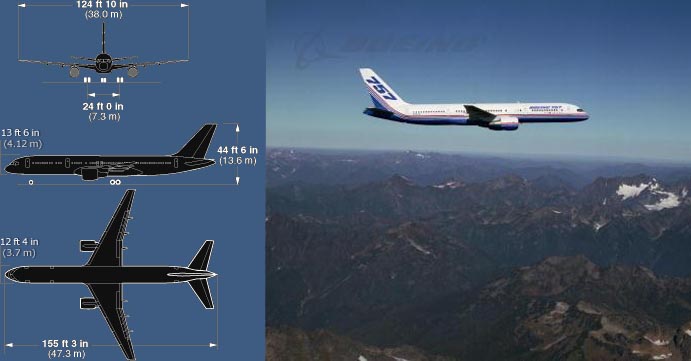
left portion: source1 right portion: source2 (height and width notation to graphic added by me)
Next, let�s look at the Pentagon.
The Pentagon
The Pentagon was designed in the early 40's and was completed in only 16 months on Jan 14, 1943. The shortages of materials required for war production raised many design and construction problems. The use of reinforced concrete in lieu of formed steel for the building made possible a saving of 43,000 tons of steel, more than enough to build a battleship. The use of concrete ramps rather than elevators further reduced steel requirements. Drainage pipes were concrete; ducts were fiber, interior doors were wood. An unusual wall design - concrete spandrels carried to window sill level - eliminated many miles of through-wall copper flashing.(Source1) (Source2)
Recent renovations and upgrades to the building were nearing completionon the side hit on 9-11 and performed reasonably well considering they were not designed to withstand aircraft impact. On September 11, when an American Airlines Boeing 757 crashed into the Pentagon, home of the U.S. Department of Defense (DoD), about 20,000 people were at work in this, the largest office building in the world. Yet according to the DoD casualty update on October 1, only 125 Pentagon employees were killed along with the 64 from the fated airliner. (source - Architecture Week) <- Click for full article
The exterior walls had been reinforced with steel beams and columns, bolted where they met at each floor. Some of these reinforced walls very near the point of impact remained in place for a half hour before collapsing, allowing uncounted hundreds to escape. "Had we not undertaken this effort," said Evey at a press briefing on September 15, "this could have been much, much worse."
Now, I'm sure everyone can agree that the above information is a matter of public record, and none of it is incorrect, altered, or misquoted in any way to support either side of the case. It is all merely factual information that we will refer to in the following sections.
[Note: I was unintentionally misleading in a previous post when I said the Pentagon didn't use a steel beam construction - while that is still true for the original design, it was reinforced in various areas during the upgrades to include steel beams and columns in some areas of the renovations.]
Quoted from ArchitectureWeek.com :
In addition to major overhauls of the mechanical and electrical systems, the Wedge One renovation included the fire sprinklers, automatic fire doors, and the steel which saved many lives on the day of the attack.
The blast-resistant windows were nearly two inches (5 centimeters) thick. Some of them remain remarkably intact and in place adjacent the point of impact. Some were popped out of their frames by the force of the exploding jet fuel, but they fell without breaking or splintering.
Also on the exterior walls, between the steel columns, the renovation crew had placed Kevlar cloth, similar to the material used for bullet-proof vests. This had the effect of holding together building materials so they wouldn't become deadly projectiles in an explosion.
Looking At the Big Picture
From facts contained above, we can all agree that:
The length of the outside wall on any side of the pentagon is 921 feet.
The wingspan of a 757 is 124 feet 10 inches.
Now, everyone can agree that 921/125= roughly 7.4 right?
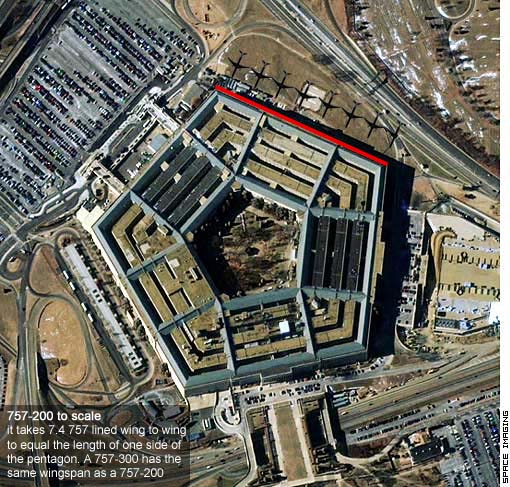
Given the size of the 757, and the size of the Pentagon, the damaged area fits in peftectly with the dimensions of both the aircraft and the building.
Look at the hole in the building
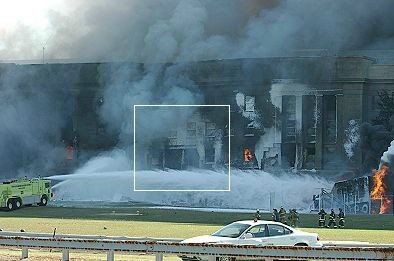

Here is the hole in the building - it's been reported by at least a dozen different sources (including conspiracy theory sites) to be a 16 to 20 foot hole. That is really interesting when you take into account the fact that the 757 body is 12 ft 4in wide and 13 ft 6in high. (Here is where I was mistaken in the past, like so very many others I was led astray by the HEIGHT of the aircraft, which isactually the measurement from the wheels-down to the tip of the tail. That measurement is for aircraft hangar clearance, not the SIZE of the aircraft.) The 757 is basically a cylinder that is 13 feet across. It then should not be surprising that it would create something around a thirteen foot hole in the side of the building.
Look at the nose-on view of a 757 - you can see the body is slightly less than 1/3 the size of the height of the aircraft. The tail certainly isn't going to punch a hole through a reinforced concrete wall; that is why there is no 40 foot hole in the front of the Pentagon in any photos. A 40 foot object didn't hit it, a 13 foot object did.
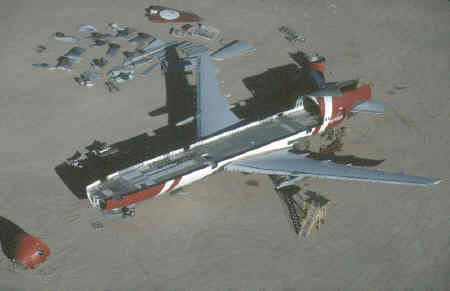
Also, as I showed earlier: Here is an L1011 (it's a larger plane than a 757 - but the basic design of how a plane body is built is the same) being scrapped, you can see that almost ALL of the support structure is in the bottom 2/5 of the plane. This is the part that punched the hole in the Pentagon, the rest of the thin, hollow, top of the plane just shredded into chunks, some of which are laying on the lawn and around the rescue vehicles. Most of a commercial airliner is just a thin aluminum shell, insulation, a thin plastic inner liner, some carpet and seats. They're designed to be as light as possible so they can carry more cargo and more people while using less fuel and at the same time remain "safe".
It is a given that the majority of mass is going to be in the bottom half of the aircraft - the primary structure and heaviest parts are all located there, as is the luggage and any freight.
But lets reinforce this as fact with a photo of a 757-300 being built. (Remember, the only difference between a 757-200 and a 757-300 is the length of the body, and the wings on the 757-300 are reinforced and slightly deeper - the height and width and wingspan remain identical.)

(source) We should also make a note of the yellow primer used on the interior of the rear section.

This image shows the light green primer used on the primary structure components in the 757 (Boeing uses the same yellow primer and the same green primer on almost every single part of every single 757 and 767 built).
What does the green or yellow primer have to do with anything? Well, we'll take a look at the aircraft parts from the Pentagon wreckage photos below.
Ok, but how did a hollow tube, made of mostly aluminium, manage to punch through the Pentagon? I'm happy to try to help explain it with the aid of the good folks at Perdue University. We'll get to that in a moment.
Examining Ground Debris
Landing Gear Evidence
Rim photographed in the Pentagon wreckage. You can clearly see it is a double bead design as required by the NTSB, and you can also see it has had 90% of the rim edge smashed off in the crash.

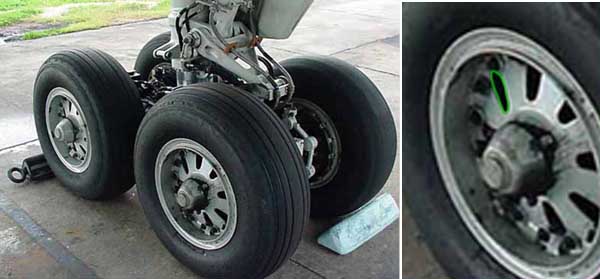
Some people have tried to claim that the rims are different from a 757 rim - well here (bottom) is a 757-200 rim from an American Airlines 757, I've outlined the exact same symmetrical holes. I think perhaps some people are thrown off by the balancing led weights attached on the rims in the bottom photo? Have you never taken your car in for a wheel alignment and tire balancing? This is clearly the same kind of rim found on a 757. (The hub-covers/grease-covers are not present for obvious reasons - to remove one you pop it off with a flathead screw driver... so how would you expect it to stay on in a 400mph impact with a reinforced concrete wall?)
Landing gear strut - appears to be from the nose gear - note how charred the area around it is.
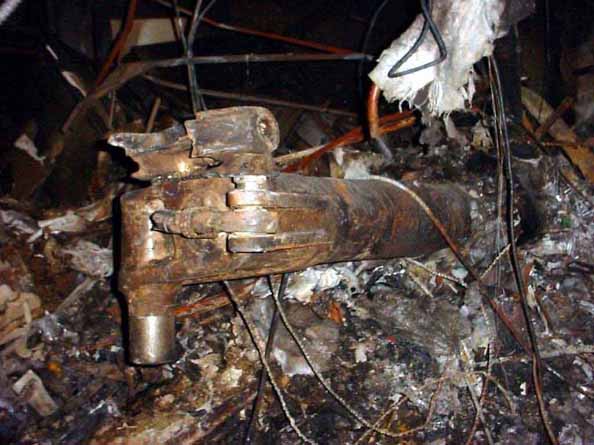
The next photo is from the cover from one of the conspiracy sites that demands "where is the plane?" -- they must not have looked very hard, there are 2 obvious chunks of it in the photo. Another rim from the airplane on the right, and a large chunk of bulkhead on the left.
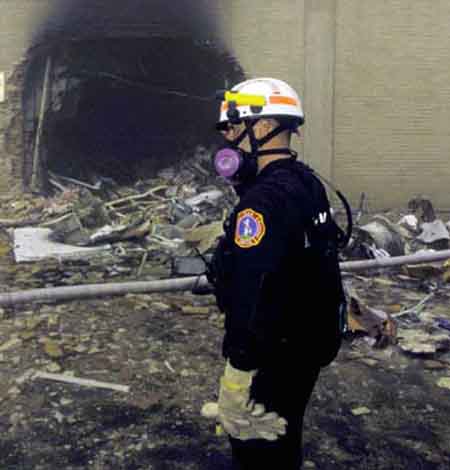
Below: More parts from inside the 757 - note the Boeing green primer on 3 parts in this photo - two circled.
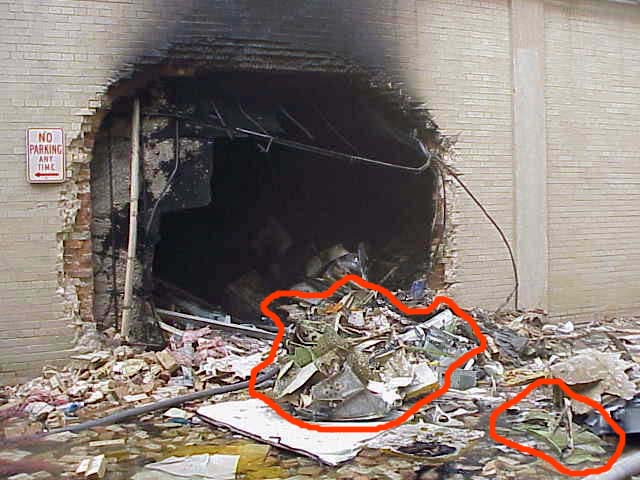
Below, another photo of a tire with the same pattern as ones used on a 757, found in the Pentagon wreckage.

Engine Evidence
Let�s take a look at some of the ground debris that appears to be related to an aircraft engine. Many different sites and posts have reported that the 757 uses Rolls-Royce engines [RB211-535E4B] - however it should be noted, for the sake of thuroughness, that American Airlines also use Pratt & Witney engines [PW2037] in many of their 757 fleet. You can also view this information on their website. (The 757 fleets around the world actually use over six different kinds of engines.) The 757 that is reported to have hit the Pentagon was using RB211-535E4B engines.
Here is are photos of some apparent engine parts from the Pentagon crash site.
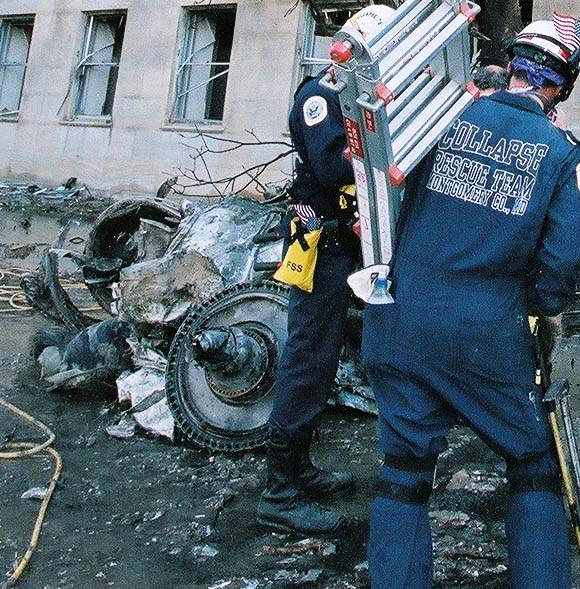
Image portion cropped from (source) - Another View
What is seen in this photo is most likely the APU (Aux Power Unit) used in a 757 that is equipped with Rolls-Royce RB211 engines. The APU (Honeywell GTCP331-200) is located in the tail section of the aircraft (that's what the large vent that looks like a 3rd jet engine is) as edvidenced on this technical rescue reference aid from Boeing. Boeing 757 reference website. These small turbine engines are quite common on modern turbine & turbofan passenger aircraft, and are used to furnish ground auxillary power while the main engines are shut down during ground operations. An online training aid lets you Play around with the controls on a 757/767 instrument pannel.
There have been some people who claim that a Global Hawk was what hit the Pentagon. Here is what John W. Brown, spokesman for Rolls Royce (Indianapolis), had to say about the part in the photo above �It is not a part from any Rolls Royce engine that I�m familiar with, and certainly not the AE 3007H made here in Indy.� (Of course it wouldn't be anything he's familiar with, it's a powerplant made by Honeywell.) The AE 3007 engines are used in small commuter jets such as the Cessna Citation; the AE 3007H is also used in the military�s unmanned aircraft, the Global Hawk. The Global Hawk is manufactured by Northrop Grumman�s subsidiary Ryan Aeronautical, which it acquired from Teledyne, Inc. in July 1999. A detailed view of what the turbofan that powers the Global Hawk looks like - I'm sure you can see it'stoo small to be anything in the pictures contained here or anywhere else in the Pentagon crash evidence. Also visible in this photo, one of the 757's blue passenger seats to the left of the turbine, and possibly a 2nd seat above the other seat.
Below is a significant portion of a badly smashed RB211 engine in the Pentagon wreckage - what appears to be the diffusor section of the compressor, one of the pumps remains partially attached, some hoses and the familiar webbed wire wraps (to the right of the main ring) and some of the Boeing yellow primed support structure is lying beside it (left, with rivets - again: note the yellow primer, we'll cover that further down).
Reference: Image of the engine used on the 757 (it's the rightmost one, top row) Rolls-Royce
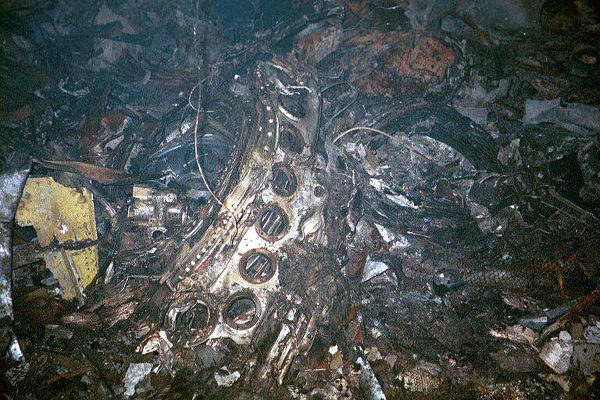
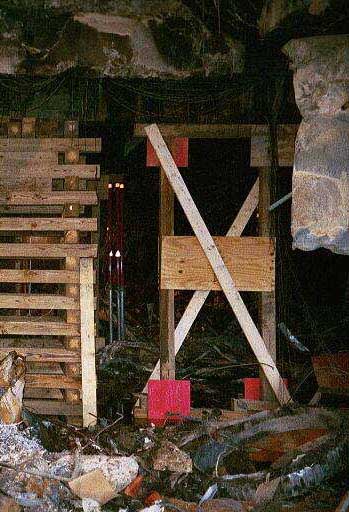
Another engine part, bottom right.
Below: Evidence of the right engine impact on the side of the building is evident on the large pillar being sprayed with fire retardant. (click photo for huge version)

The hit lightpoles, and damaged vehicles in the flightpath (click for larger images)

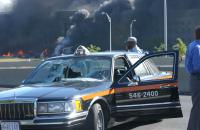


The debris field of small chunks of plane witnesses said debris "rained down for minutes after the crash". (click for larger images)



The wreckage with the markings
(click to view original enlarged image)

Some people have said "Yeah but how big is it?" (Again some people have a hard time judging distances in a photo without a reference object - well, here's a reference object - a 3/4 ton truck driving right behind it...
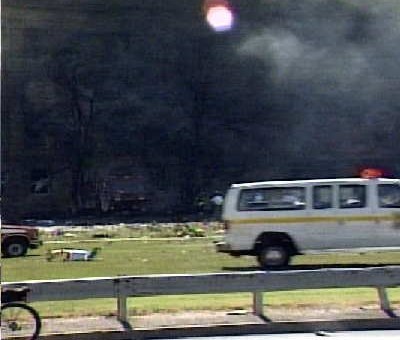
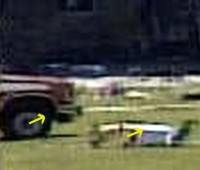
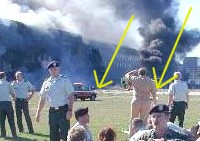
We can see that the part is approximately 3.5 to 4 feet long; the truck has either a 17 inch or an 18 inch wheel as a reference and is about 2 feet behind it; only cars or light trucks have 14, 15 and 16 inch wheels. I think it's conservative to say that the part is 2 times as long as the truck's tire (36 inches).
Here is another angle of the exact same piece in question - notice the people standing off to the right of it. More importantly, notice all the other small bits of the aircraft skin laying around.

Both (larger) Photos by Journalist 1st Class Mark D. Faram.
Even the black boxes have been recovered, the reason given for not playing the flight voice recorder for the media was that it wouldn't serve any use other than to cause more emotional pain to family members (I agree with them frankly).
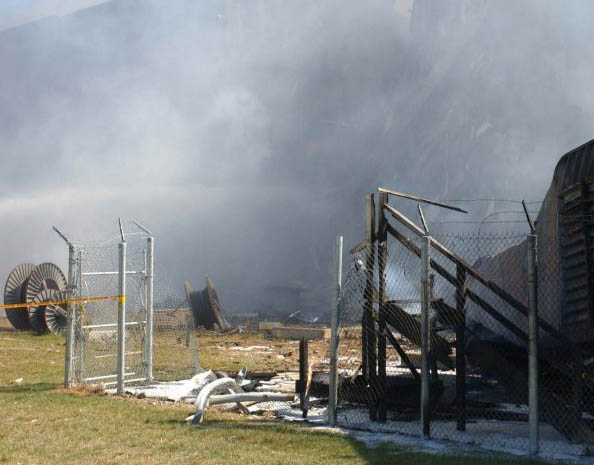
Area of fence to the right of the impact area partially flattened by the right engine of the plane. Note how a couple of the poles are bent right over, some are sheered off at the top, yet the pole and fence portion on the left is untouched (obviously the right engine took out the fence to the right of those poles) and the entire back side of the fence has been torn away. The generator was hit by the right wing and engine before the 757 hit the building - the damage is evidenced by other photos of the crash area.
Closeup of generator smashed in the front and gouged on the top - hard to image a missile accomplishing both of these. But if the right engine of a 757 hit the front of the generator, part of the wing could gouge the top. At the very least, something very large, and very heavy smashed into this extremely heavy desil generator.
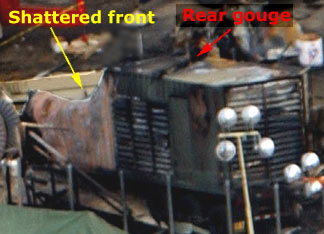

Click the image on the left to view a large top-down image of the impact area, including the large desil generator which is visibly damaged, and actually spun ~45 degrees from the impact! Most importantly it is spun ~45 degreestowards the building - if this was a missile or a bomb, the explosion could ONLY have spun it away from the building.

The Gate Camera
Some people don't seem to see perspective correctly. I've zoomed in, and compared the two frames over and over - here is what I see as the airplane. I will repeat, however, that this is terrible evidence due to the horrible quality of the original images. I do believe, however, that the white smoke in the images is caused by one or more damaged engine from the impact with the multiple light poles on the way in (as seen in the above image).

I stuck in a 757 that was at relatively the same angle - except it's banking slightly to starboard instead of to port - hence the ONE wing is out of place. If it was banking slightly to port it would fit perfectly... However, once again - this is entirely subjective and the image quality from the released surveillance camera is not good enough to form a factual opinion.
Lets look at the physics involved
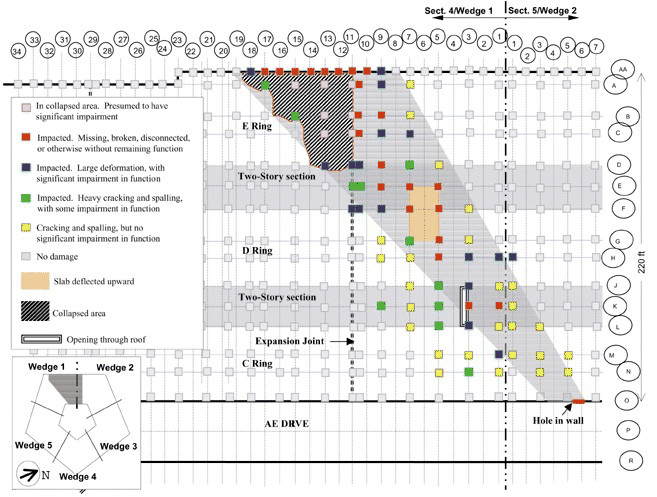
Engineers, computer scientists and graphics technology experts at Purdue University have created the first publicly available simulation that uses scientific principles to study in detail what theoretically happened when the Boeing 757 crashed into the Pentagon last Sept. 11
Using simulation software called LS-Dyna, the smart folks use the physically accurate simulation results as input to animations and visualizations to produce a vivid reenactment of the impact of the aircraft on the Pentagon building and provide the larger team with the necessary data to construct these using 3D Studio Max, AutoCAD, and research tools.
Now we can see, through a very competent and valid simulator, what happened in the attack on the Pentagon. Click here to view a video generated by the simulator. Or, click here to read the white paper.
In layman's terms the crash dynamics worked like so: A large hollow tube, with a belly full of luggage, a passenger bay with 60 people, and wings full of fuel smashed into the side of an almost solid object while moving at a tremendous speed (somewhere around 350-400mph). When the 225,000lb+ plane hit, it smashed apart with such force from the crash that it became like one massive column of liquid (no, the plane didn't melt or turn into liquid, it just acted like one physically - mountainslides act the same way, a million tons of rock acts like a large field of liquid during a landslide even if no water is present). All the small parts, luggage, people, seats, and all the tens of thousands of pounds of fuel acting like a massive river came crashing into the wall of the Pentagon. This force burst through the outside wall and flowed through the inside to the next wall, and momentum carried this mass until it finally ran out of inertia at the 3rd ring.
Plane hitting WTC (another example of crash fluid dynamics) - RealAudio Required - note how the 767 "liquifies" and flows through the WTC tower.
Please do read the information on the Perdue website yourself - I don't do it justice with my one paragraph of paraphrasing!
Pentagon photo taken by satellite on 9/07/01 - - Pentagon photo taken by satellite on 9/12/01


(click either image for larger version) Source: Space Imaging
Eye Witness Testimony
Lets look at some eye witness testimony sticking only to people who saw a plane hit the building, and not look at people who saw an airliner, but didn't see an airplane hit the building because they looked away or were too far away (behind a hill, behind a building, etc) to see it actually hit the building.
"Aydan Kizildrgli, an English language student who is a native of Turkey, saw the jetliner bank slightly then strike a western wall of the huge five-sided building that is the headquarters of the nation's military. 'There was a big boom,' he said. 'Everybody was in shock. I turned around to the car behind me and yelled "Did you see that?" Nobody could believe it.'"
- "Bush Vows Retaliation for 'Evil Acts'." USA Today, 11 Sep 2001
"Frank Probst, an information management specialist for the Pentagon Renovation Program, left his office trailer near the Pentagon's south parking lot at 9:36 a.m. Sept. 11. Walking north beside Route 27, he suddenly saw a commercial airliner crest the hilltop Navy Annex. American Airlines Flight 77 reached him so fast and flew so low that Probst dropped to the ground, fearing he'd lose his head to its right engine."
- "A Defiant Recovery." The Retired Officer Magazine, January 2002
"Omar Campo, a Salvadorean, was cutting the grass on the other side of the road when the plane flew over his head. 'It was a passenger plane. I think an American Airways plane,' Mr Campo said. 'I was cutting the grass and it came in screaming over my head. I felt the impact. The whole ground shook and the whole area was full of fire. I could never imagine I would see anything like that here.'"
- "Pentagon Eyewitness Accounts." The Guardian, 12 Sep 2001
"Afework Hagos, a computer programmer, was on his way to work but stuck in a traffic jam near the Pentagon when the plane flew over. 'There was a huge screaming noise and I got out of the car as the plane came over. Everybody was running away in different directions. It was tilting its wings up and down like it was trying to balance. It hit some lampposts on the way in.'"
- "Pentagon Eyewitness Accounts." The Guardian, 12 Sep 2001
"Henry Ticknor, intern minister at the Unitarian Universalist Church of Arlington, Virginia, was driving to church that Tuesday morning when American Airlines Flight 77 came in fast and low over his car and struck the Pentagon. 'There was a puff of white smoke and then a huge billowing black cloud,' he said."
- "Hell on Earth." UU World, Jan/Feb 20
"We were the only people, we think, who saw it live," Dan Creed said. He and two colleagues from Oracle software were stopped in a car near the Naval Annex, next to the Pentagon, when they saw the plane dive down and level off. "It was no more than 30 feet off the ground, and it was screaming. It was just screaming. It was nothing more than a guided missile at that point," Creed said. "I can still see the plane. I can still see it right now. It's just the most frightening thing in the world, going full speed, going full throttle, its wheels up," -Ahwatukee Foothill News
Gary Bauer former Presidential candidate, "I looked at the woman sitting in the car next to me. She had this startled look on her face. We were all thinking the same thing. We looked out the front of our windows to try to see the plane, and it wasn�t until a few seconds later that we realized the jet was coming up behind us on that major highway. And it veered to the right into the Pentagon. The blast literally rocked all of our cars. It was an incredible moment."Massachusetts News
Sean Boger, Air Traffic Controller and Pentagon tower chief - "I just looked up and I saw the big nose and the wings of the aircraft coming right at us and I just watched it hit the building," Air Traffic Controller and Pentagon tower chief Sean Boger said. "It exploded. I fell to the ground and covered my head. I could actually hear the metal going through the building." dcmilitary.com November 16, 2001
"The only way you could tell that an aircraft was inside was that we saw pieces of the nose gear. The devastation was horrific. It was obvious that some of the victims we found had no time to react. The distance the firefighters had to travel down corridors to reach the fires was a problem. With only a good 25 minutes of air in their SCBA bottles, to save air they left off their face pieces as they walked and took in a lot of smoke," Captain Defina said. Captain Defina was the shift commander [of an aircraft rescue firefighters crew.] NFPA JournalNovember 1, 2001
That's just a small smattering of people who have gone on record as seeing the plane, and the plane hit the Pentagon. I could have included the dozens of people who saw the plane, but didn't see it hit (because it went behind a bridge, a hill, or some trees), but I choose only to post the ones that sounded the most valid and actually saw the plane hit the building. (I included the one firechief who states he saw some plane wreckage during firefighting/rescue attempts.) There are most likely twenty times more that either haven't been publicly recorded as seeing the crash, or simply don't want the attention. You can't honeslty sit there and deny the witnesses, the photographs, the facts, the science, and the reality that there was a terrorist attack on the Pentagon if you look at everything available and not one single tidbit of information at a time.
911 Tape of EMV responding to the Pentagon - includes video outside and inside the building in some areas. (Real Audio Required)
Conclusion
I highly doubt that local firefighters would be involved in any sort of a coverup. I highly doubt that local police officers would be involved in any sort of a government cover up. Cops and firemen are just average Joes like you and me, who go home to the wife and kids, and just try to make a living and have a good life for their families (I have many friends in both professions - of course the firemen are usually more stable marriage-wise because of their job but that doesn't make the cops any less human than you or I). The men and women who pulled over a hundred people (dead and alive) out of that building would more likely than not have noticed somebody carrying over 60 bodies into the middle of the fire they were fighting. To say that the plane that hit the Pentagon was not filled with every single person who died in this terrorist attack (not counting the unfortunate people inside the building) is one thing and one thing only - ignorant.
Review the facts
Size of 757 matches the initial size of hole in the building - somewhere between 13 and 16 feet (757 is 13 feet wide/high)
Rims found in building match those of a 757
Small turbine engine outside is an APU
Same engine has been clearly stated to not match a Global Hawk engine
Blue seats from 757 laying on ground in photos
Part of "American" fuselage logo visible in more than 1 photo
Engine parts photographed inside match a Rolls-Royce RB211
Structural components photographed in wreckage match Boeing paint primer schemes
Large deisel generator in front of building hit by a large heavy object
Large deisel engine outside is spun towards the building - could not be result of bomb blast or missile explosion
Multiple eye witnesses say they saw an airliner
Multiple eye witnesses say they saw an airliner hit the Pentagon
60+ bodies, matching the passenger list and flight crew roster identified and returned to families from Pentagon wreckage
You cannot dispute the facts, a 757 hit the Pentagon killing everyone onboard and many inside the building. It was a terrorist attack and the only fault with the government here is with their failure to prevent or stop it.
For an alternative viewpoint to this article, visit The Pentagon Was Not Hit by a 757.
[edit on 14-5-2004 by SkepticOverlord]
ATS ADMIN NOTE: Nearly five years after the catastrophic events of 9/11/2001, many questions still surround this defining moment of the post-cold-war world. Among the many questions are the various speculations that the Pentagon attack was by some other means than a hijacked passenger airliner.
This thread has become the single-most popular piece of content on AboveTopSecret.com, sparking inspired debate and research throughout the Internet. However, the volume of material and issues on this subject (and in this thread alone) is overwhelming, making specific conclusions difficult, and evolution beyond the issue of what hit the Pentagon impossible.
In an effort to bring new clarity to this important aspect of the 9/11 conspiracy debate, we're beginning the "9/11 Fine Focus Initiative" that zeros in on five key attributes of this debate. If you're not a member of ATS and believe you have important contributions to this debate, please Join ATS and contribute to this initiative.
Also, if you've authored a scholarly analysis of this issue, please Contact Us about promoting your work, or becoming an ATS Conspiracy Master and adding your material to our upcoming ConspiracyMasters.com website for experts only.
ATS ADMIN NOTE: Nearly five years after the catastrophic events of 9/11/2001, many questions still surround this defining moment of the post-cold-war world. Among the many questions are the various speculations that the Pentagon attack was by some other means than a hijacked passenger airliner. This thread has become the single-most popular piece of content on AboveTopSecret.com, sparking inspired debate and research throughout the Internet. However, the volume of material and issues on this subject (and in this thread alone) is overwhelming, making specific conclusions difficult, and evolution beyond the issue of what hit the Pentagon impossible.
Evidence That A Boeing 757 Really Did Impact the Pentagon on 9/11
I've decided the best way to do this is to state the evidence, and facts, and come to a conclusion. Everything I list here as evidence includes links to sources, names of individuals, and notes if I have added any comments or visual aids to any photos. I may repeat some information and images in this post (from images and information previously posted), and I apologize for the length of the information, and for the size of some of the photos, but I can see no other way to provide the information without losing clarity and quality and most importantly accuracy. It is apparent that without the entire collection of evidence people quickly forget something outlined on a previous post. I will freely admit in this post that I was incorrect on some facts in my previous posts, and I will correct these mistakes here. I will also try to link every image to its original source, unless it is an image I have added comments or visual aids to.Did a 757 hit the Pentagon on 9-11
First let�s start with the factual information available on hand.
The 757-200
As we can see from the freely available information for the Boeing 757 (from the Boeing website). The 757 is a midsized commercial airliner designed for short haul and medium haul routes (Medium Range Transport (MR-TR)), although since its release, and the subsequent discovery of the Wake Vortex it leaves behind the FAA has classified the 757 as a "Heavy" aircraft; the FAA places the 757 in the Geometric Design Classification IV, and an ATC Operation Class C. (source)
The 757-200 dimensions:
Tail Height: 44 ft 6 in (13.6m)
Length: 155 ft 3 in (47.32m)
Wingspan: 124 ft 10 in (38.05m)
Body Exterior Width: 12 ft 4 in (3.7m)
Fuel Capacity: 11,489 us gal (43,490l / 43,490kg)
Maximum Takeoff weight: 255,000lb (115,680kg)
Typical Cruise Speed: 0.80 Mach (573.6mph / 956kmh)
Engines used on a 757: Two 166.4kN (37,400lb) Rolls-Royce RB211-535C turbofans, or 178.8kN (40,200lb) RB211-535E4s, or 193.5kN (43,500lb) RB211-535E4-Bs, or 162.8kN (36,600lb) Pratt & Whitney PW2037s, or two 178.4kN (40,100lb) PW2040s, or 189.5kN (42,600lb) PW2043s.(source1)www.flybernhard.de..." target="_blank" class="postlink"> (source2)
Auxiliary Power Unit: Honeywell GTCP331-200
Click here to ->take a walk around inside a Boeing 757.

left portion: source1 right portion: source2 (height and width notation to graphic added by me)
Next, let�s look at the Pentagon.
The Pentagon
The Pentagon was designed in the early 40's and was completed in only 16 months on Jan 14, 1943. The shortages of materials required for war production raised many design and construction problems. The use of reinforced concrete in lieu of formed steel for the building made possible a saving of 43,000 tons of steel, more than enough to build a battleship. The use of concrete ramps rather than elevators further reduced steel requirements. Drainage pipes were concrete; ducts were fiber, interior doors were wood. An unusual wall design - concrete spandrels carried to window sill level - eliminated many miles of through-wall copper flashing.(Source1) (Source2)
Recent renovations and upgrades to the building were nearing completionon the side hit on 9-11 and performed reasonably well considering they were not designed to withstand aircraft impact. On September 11, when an American Airlines Boeing 757 crashed into the Pentagon, home of the U.S. Department of Defense (DoD), about 20,000 people were at work in this, the largest office building in the world. Yet according to the DoD casualty update on October 1, only 125 Pentagon employees were killed along with the 64 from the fated airliner. (source - Architecture Week) <- Click for full article
The exterior walls had been reinforced with steel beams and columns, bolted where they met at each floor. Some of these reinforced walls very near the point of impact remained in place for a half hour before collapsing, allowing uncounted hundreds to escape. "Had we not undertaken this effort," said Evey at a press briefing on September 15, "this could have been much, much worse."
Now, I'm sure everyone can agree that the above information is a matter of public record, and none of it is incorrect, altered, or misquoted in any way to support either side of the case. It is all merely factual information that we will refer to in the following sections.
[Note: I was unintentionally misleading in a previous post when I said the Pentagon didn't use a steel beam construction - while that is still true for the original design, it was reinforced in various areas during the upgrades to include steel beams and columns in some areas of the renovations.]
Quoted from ArchitectureWeek.com :
In addition to major overhauls of the mechanical and electrical systems, the Wedge One renovation included the fire sprinklers, automatic fire doors, and the steel which saved many lives on the day of the attack.
The blast-resistant windows were nearly two inches (5 centimeters) thick. Some of them remain remarkably intact and in place adjacent the point of impact. Some were popped out of their frames by the force of the exploding jet fuel, but they fell without breaking or splintering.
Also on the exterior walls, between the steel columns, the renovation crew had placed Kevlar cloth, similar to the material used for bullet-proof vests. This had the effect of holding together building materials so they wouldn't become deadly projectiles in an explosion.
Looking At the Big Picture
From facts contained above, we can all agree that:

Given the size of the 757, and the size of the Pentagon, the damaged area fits in peftectly with the dimensions of both the aircraft and the building.
Look at the hole in the building


Here is the hole in the building - it's been reported by at least a dozen different sources (including conspiracy theory sites) to be a 16 to 20 foot hole. That is really interesting when you take into account the fact that the 757 body is 12 ft 4in wide and 13 ft 6in high. (Here is where I was mistaken in the past, like so very many others I was led astray by the HEIGHT of the aircraft, which isactually the measurement from the wheels-down to the tip of the tail. That measurement is for aircraft hangar clearance, not the SIZE of the aircraft.) The 757 is basically a cylinder that is 13 feet across. It then should not be surprising that it would create something around a thirteen foot hole in the side of the building.
Look at the nose-on view of a 757 - you can see the body is slightly less than 1/3 the size of the height of the aircraft. The tail certainly isn't going to punch a hole through a reinforced concrete wall; that is why there is no 40 foot hole in the front of the Pentagon in any photos. A 40 foot object didn't hit it, a 13 foot object did.

Also, as I showed earlier: Here is an L1011 (it's a larger plane than a 757 - but the basic design of how a plane body is built is the same) being scrapped, you can see that almost ALL of the support structure is in the bottom 2/5 of the plane. This is the part that punched the hole in the Pentagon, the rest of the thin, hollow, top of the plane just shredded into chunks, some of which are laying on the lawn and around the rescue vehicles. Most of a commercial airliner is just a thin aluminum shell, insulation, a thin plastic inner liner, some carpet and seats. They're designed to be as light as possible so they can carry more cargo and more people while using less fuel and at the same time remain "safe".
It is a given that the majority of mass is going to be in the bottom half of the aircraft - the primary structure and heaviest parts are all located there, as is the luggage and any freight.
But lets reinforce this as fact with a photo of a 757-300 being built. (Remember, the only difference between a 757-200 and a 757-300 is the length of the body, and the wings on the 757-300 are reinforced and slightly deeper - the height and width and wingspan remain identical.)

(source) We should also make a note of the yellow primer used on the interior of the rear section.

This image shows the light green primer used on the primary structure components in the 757 (Boeing uses the same yellow primer and the same green primer on almost every single part of every single 757 and 767 built).
What does the green or yellow primer have to do with anything? Well, we'll take a look at the aircraft parts from the Pentagon wreckage photos below.
Ok, but how did a hollow tube, made of mostly aluminium, manage to punch through the Pentagon? I'm happy to try to help explain it with the aid of the good folks at Perdue University. We'll get to that in a moment.
Examining Ground Debris
Landing Gear Evidence
Rim photographed in the Pentagon wreckage. You can clearly see it is a double bead design as required by the NTSB, and you can also see it has had 90% of the rim edge smashed off in the crash.


Some people have tried to claim that the rims are different from a 757 rim - well here (bottom) is a 757-200 rim from an American Airlines 757, I've outlined the exact same symmetrical holes. I think perhaps some people are thrown off by the balancing led weights attached on the rims in the bottom photo? Have you never taken your car in for a wheel alignment and tire balancing? This is clearly the same kind of rim found on a 757. (The hub-covers/grease-covers are not present for obvious reasons - to remove one you pop it off with a flathead screw driver... so how would you expect it to stay on in a 400mph impact with a reinforced concrete wall?)
Landing gear strut - appears to be from the nose gear - note how charred the area around it is.

The next photo is from the cover from one of the conspiracy sites that demands "where is the plane?" -- they must not have looked very hard, there are 2 obvious chunks of it in the photo. Another rim from the airplane on the right, and a large chunk of bulkhead on the left.

Below: More parts from inside the 757 - note the Boeing green primer on 3 parts in this photo - two circled.

Below, another photo of a tire with the same pattern as ones used on a 757, found in the Pentagon wreckage.

Engine Evidence
Let�s take a look at some of the ground debris that appears to be related to an aircraft engine. Many different sites and posts have reported that the 757 uses Rolls-Royce engines [RB211-535E4B] - however it should be noted, for the sake of thuroughness, that American Airlines also use Pratt & Witney engines [PW2037] in many of their 757 fleet. You can also view this information on their website. (The 757 fleets around the world actually use over six different kinds of engines.) The 757 that is reported to have hit the Pentagon was using RB211-535E4B engines.
Here is are photos of some apparent engine parts from the Pentagon crash site.

Image portion cropped from (source) - Another View
What is seen in this photo is most likely the APU (Aux Power Unit) used in a 757 that is equipped with Rolls-Royce RB211 engines. The APU (Honeywell GTCP331-200) is located in the tail section of the aircraft (that's what the large vent that looks like a 3rd jet engine is) as edvidenced on this technical rescue reference aid from Boeing. Boeing 757 reference website. These small turbine engines are quite common on modern turbine & turbofan passenger aircraft, and are used to furnish ground auxillary power while the main engines are shut down during ground operations. An online training aid lets you Play around with the controls on a 757/767 instrument pannel.
There have been some people who claim that a Global Hawk was what hit the Pentagon. Here is what John W. Brown, spokesman for Rolls Royce (Indianapolis), had to say about the part in the photo above �It is not a part from any Rolls Royce engine that I�m familiar with, and certainly not the AE 3007H made here in Indy.� (Of course it wouldn't be anything he's familiar with, it's a powerplant made by Honeywell.) The AE 3007 engines are used in small commuter jets such as the Cessna Citation; the AE 3007H is also used in the military�s unmanned aircraft, the Global Hawk. The Global Hawk is manufactured by Northrop Grumman�s subsidiary Ryan Aeronautical, which it acquired from Teledyne, Inc. in July 1999. A detailed view of what the turbofan that powers the Global Hawk looks like - I'm sure you can see it'stoo small to be anything in the pictures contained here or anywhere else in the Pentagon crash evidence. Also visible in this photo, one of the 757's blue passenger seats to the left of the turbine, and possibly a 2nd seat above the other seat.
Below is a significant portion of a badly smashed RB211 engine in the Pentagon wreckage - what appears to be the diffusor section of the compressor, one of the pumps remains partially attached, some hoses and the familiar webbed wire wraps (to the right of the main ring) and some of the Boeing yellow primed support structure is lying beside it (left, with rivets - again: note the yellow primer, we'll cover that further down).
Reference: Image of the engine used on the 757 (it's the rightmost one, top row) Rolls-Royce


Another engine part, bottom right.
Below: Evidence of the right engine impact on the side of the building is evident on the large pillar being sprayed with fire retardant. (click photo for huge version)

The hit lightpoles, and damaged vehicles in the flightpath (click for larger images)




The debris field of small chunks of plane witnesses said debris "rained down for minutes after the crash". (click for larger images)



The wreckage with the markings
(click to view original enlarged image)

Some people have said "Yeah but how big is it?" (Again some people have a hard time judging distances in a photo without a reference object - well, here's a reference object - a 3/4 ton truck driving right behind it...



We can see that the part is approximately 3.5 to 4 feet long; the truck has either a 17 inch or an 18 inch wheel as a reference and is about 2 feet behind it; only cars or light trucks have 14, 15 and 16 inch wheels. I think it's conservative to say that the part is 2 times as long as the truck's tire (36 inches).
Here is another angle of the exact same piece in question - notice the people standing off to the right of it. More importantly, notice all the other small bits of the aircraft skin laying around.

Both (larger) Photos by Journalist 1st Class Mark D. Faram.
Even the black boxes have been recovered, the reason given for not playing the flight voice recorder for the media was that it wouldn't serve any use other than to cause more emotional pain to family members (I agree with them frankly).

Area of fence to the right of the impact area partially flattened by the right engine of the plane. Note how a couple of the poles are bent right over, some are sheered off at the top, yet the pole and fence portion on the left is untouched (obviously the right engine took out the fence to the right of those poles) and the entire back side of the fence has been torn away. The generator was hit by the right wing and engine before the 757 hit the building - the damage is evidenced by other photos of the crash area.
Closeup of generator smashed in the front and gouged on the top - hard to image a missile accomplishing both of these. But if the right engine of a 757 hit the front of the generator, part of the wing could gouge the top. At the very least, something very large, and very heavy smashed into this extremely heavy desil generator.


Click the image on the left to view a large top-down image of the impact area, including the large desil generator which is visibly damaged, and actually spun ~45 degrees from the impact! Most importantly it is spun ~45 degreestowards the building - if this was a missile or a bomb, the explosion could ONLY have spun it away from the building.

The Gate Camera
Some people don't seem to see perspective correctly. I've zoomed in, and compared the two frames over and over - here is what I see as the airplane. I will repeat, however, that this is terrible evidence due to the horrible quality of the original images. I do believe, however, that the white smoke in the images is caused by one or more damaged engine from the impact with the multiple light poles on the way in (as seen in the above image).

I stuck in a 757 that was at relatively the same angle - except it's banking slightly to starboard instead of to port - hence the ONE wing is out of place. If it was banking slightly to port it would fit perfectly... However, once again - this is entirely subjective and the image quality from the released surveillance camera is not good enough to form a factual opinion.
Lets look at the physics involved

Engineers, computer scientists and graphics technology experts at Purdue University have created the first publicly available simulation that uses scientific principles to study in detail what theoretically happened when the Boeing 757 crashed into the Pentagon last Sept. 11
Using simulation software called LS-Dyna, the smart folks use the physically accurate simulation results as input to animations and visualizations to produce a vivid reenactment of the impact of the aircraft on the Pentagon building and provide the larger team with the necessary data to construct these using 3D Studio Max, AutoCAD, and research tools.
Now we can see, through a very competent and valid simulator, what happened in the attack on the Pentagon. Click here to view a video generated by the simulator. Or, click here to read the white paper.
In layman's terms the crash dynamics worked like so: A large hollow tube, with a belly full of luggage, a passenger bay with 60 people, and wings full of fuel smashed into the side of an almost solid object while moving at a tremendous speed (somewhere around 350-400mph). When the 225,000lb+ plane hit, it smashed apart with such force from the crash that it became like one massive column of liquid (no, the plane didn't melt or turn into liquid, it just acted like one physically - mountainslides act the same way, a million tons of rock acts like a large field of liquid during a landslide even if no water is present). All the small parts, luggage, people, seats, and all the tens of thousands of pounds of fuel acting like a massive river came crashing into the wall of the Pentagon. This force burst through the outside wall and flowed through the inside to the next wall, and momentum carried this mass until it finally ran out of inertia at the 3rd ring.
Plane hitting WTC (another example of crash fluid dynamics) - RealAudio Required - note how the 767 "liquifies" and flows through the WTC tower.
Please do read the information on the Perdue website yourself - I don't do it justice with my one paragraph of paraphrasing!
Pentagon photo taken by satellite on 9/07/01 - - Pentagon photo taken by satellite on 9/12/01


(click either image for larger version) Source: Space Imaging
Eye Witness Testimony
Lets look at some eye witness testimony sticking only to people who saw a plane hit the building, and not look at people who saw an airliner, but didn't see an airplane hit the building because they looked away or were too far away (behind a hill, behind a building, etc) to see it actually hit the building.
"Aydan Kizildrgli, an English language student who is a native of Turkey, saw the jetliner bank slightly then strike a western wall of the huge five-sided building that is the headquarters of the nation's military. 'There was a big boom,' he said. 'Everybody was in shock. I turned around to the car behind me and yelled "Did you see that?" Nobody could believe it.'"
- "Bush Vows Retaliation for 'Evil Acts'." USA Today, 11 Sep 2001
"Frank Probst, an information management specialist for the Pentagon Renovation Program, left his office trailer near the Pentagon's south parking lot at 9:36 a.m. Sept. 11. Walking north beside Route 27, he suddenly saw a commercial airliner crest the hilltop Navy Annex. American Airlines Flight 77 reached him so fast and flew so low that Probst dropped to the ground, fearing he'd lose his head to its right engine."
- "A Defiant Recovery." The Retired Officer Magazine, January 2002
"Omar Campo, a Salvadorean, was cutting the grass on the other side of the road when the plane flew over his head. 'It was a passenger plane. I think an American Airways plane,' Mr Campo said. 'I was cutting the grass and it came in screaming over my head. I felt the impact. The whole ground shook and the whole area was full of fire. I could never imagine I would see anything like that here.'"
- "Pentagon Eyewitness Accounts." The Guardian, 12 Sep 2001
"Afework Hagos, a computer programmer, was on his way to work but stuck in a traffic jam near the Pentagon when the plane flew over. 'There was a huge screaming noise and I got out of the car as the plane came over. Everybody was running away in different directions. It was tilting its wings up and down like it was trying to balance. It hit some lampposts on the way in.'"
- "Pentagon Eyewitness Accounts." The Guardian, 12 Sep 2001
"Henry Ticknor, intern minister at the Unitarian Universalist Church of Arlington, Virginia, was driving to church that Tuesday morning when American Airlines Flight 77 came in fast and low over his car and struck the Pentagon. 'There was a puff of white smoke and then a huge billowing black cloud,' he said."
- "Hell on Earth." UU World, Jan/Feb 20
"We were the only people, we think, who saw it live," Dan Creed said. He and two colleagues from Oracle software were stopped in a car near the Naval Annex, next to the Pentagon, when they saw the plane dive down and level off. "It was no more than 30 feet off the ground, and it was screaming. It was just screaming. It was nothing more than a guided missile at that point," Creed said. "I can still see the plane. I can still see it right now. It's just the most frightening thing in the world, going full speed, going full throttle, its wheels up," -Ahwatukee Foothill News
Gary Bauer former Presidential candidate, "I looked at the woman sitting in the car next to me. She had this startled look on her face. We were all thinking the same thing. We looked out the front of our windows to try to see the plane, and it wasn�t until a few seconds later that we realized the jet was coming up behind us on that major highway. And it veered to the right into the Pentagon. The blast literally rocked all of our cars. It was an incredible moment."Massachusetts News
Sean Boger, Air Traffic Controller and Pentagon tower chief - "I just looked up and I saw the big nose and the wings of the aircraft coming right at us and I just watched it hit the building," Air Traffic Controller and Pentagon tower chief Sean Boger said. "It exploded. I fell to the ground and covered my head. I could actually hear the metal going through the building." dcmilitary.com November 16, 2001
"The only way you could tell that an aircraft was inside was that we saw pieces of the nose gear. The devastation was horrific. It was obvious that some of the victims we found had no time to react. The distance the firefighters had to travel down corridors to reach the fires was a problem. With only a good 25 minutes of air in their SCBA bottles, to save air they left off their face pieces as they walked and took in a lot of smoke," Captain Defina said. Captain Defina was the shift commander [of an aircraft rescue firefighters crew.] NFPA JournalNovember 1, 2001
That's just a small smattering of people who have gone on record as seeing the plane, and the plane hit the Pentagon. I could have included the dozens of people who saw the plane, but didn't see it hit (because it went behind a bridge, a hill, or some trees), but I choose only to post the ones that sounded the most valid and actually saw the plane hit the building. (I included the one firechief who states he saw some plane wreckage during firefighting/rescue attempts.) There are most likely twenty times more that either haven't been publicly recorded as seeing the crash, or simply don't want the attention. You can't honeslty sit there and deny the witnesses, the photographs, the facts, the science, and the reality that there was a terrorist attack on the Pentagon if you look at everything available and not one single tidbit of information at a time.
911 Tape of EMV responding to the Pentagon - includes video outside and inside the building in some areas. (Real Audio Required)
Conclusion
I highly doubt that local firefighters would be involved in any sort of a coverup. I highly doubt that local police officers would be involved in any sort of a government cover up. Cops and firemen are just average Joes like you and me, who go home to the wife and kids, and just try to make a living and have a good life for their families (I have many friends in both professions - of course the firemen are usually more stable marriage-wise because of their job but that doesn't make the cops any less human than you or I). The men and women who pulled over a hundred people (dead and alive) out of that building would more likely than not have noticed somebody carrying over 60 bodies into the middle of the fire they were fighting. To say that the plane that hit the Pentagon was not filled with every single person who died in this terrorist attack (not counting the unfortunate people inside the building) is one thing and one thing only - ignorant.
Review the facts
You cannot dispute the facts, a 757 hit the Pentagon killing everyone onboard and many inside the building. It was a terrorist attack and the only fault with the government here is with their failure to prevent or stop it.
For an alternative viewpoint to this article, visit The Pentagon Was Not Hit by a 757.
[edit on 14-5-2004 by SkepticOverlord]
ATS ADMIN NOTE: Nearly five years after the catastrophic events of 9/11/2001, many questions still surround this defining moment of the post-cold-war world. Among the many questions are the various speculations that the Pentagon attack was by some other means than a hijacked passenger airliner.
This thread has become the single-most popular piece of content on AboveTopSecret.com, sparking inspired debate and research throughout the Internet. However, the volume of material and issues on this subject (and in this thread alone) is overwhelming, making specific conclusions difficult, and evolution beyond the issue of what hit the Pentagon impossible.
In an effort to bring new clarity to this important aspect of the 9/11 conspiracy debate, we're beginning the "9/11 Fine Focus Initiative" that zeros in on five key attributes of this debate. If you're not a member of ATS and believe you have important contributions to this debate, please Join ATS and contribute to this initiative.
Also, if you've authored a scholarly analysis of this issue, please Contact Us about promoting your work, or becoming an ATS Conspiracy Master and adding your material to our upcoming ConspiracyMasters.com website for experts only.
ATS ADMIN NOTE: Nearly five years after the catastrophic events of 9/11/2001, many questions still surround this defining moment of the post-cold-war world. Among the many questions are the various speculations that the Pentagon attack was by some other means than a hijacked passenger airliner. This thread has become the single-most popular piece of content on AboveTopSecret.com, sparking inspired debate and research throughout the Internet. However, the volume of material and issues on this subject (and in this thread alone) is overwhelming, making specific conclusions difficult, and evolution beyond the issue of what hit the Pentagon impossible.



 It's really interesting how people can gloss over an entire thread, without reading the important and fact containing posts, and still manage to offer up their opinions on the subject without doing any research for themselves. Anyone can have an opinion, it's how educated that opinion is that gives it value. [edit on 12-9-2004 by CatHerder]
It's really interesting how people can gloss over an entire thread, without reading the important and fact containing posts, and still manage to offer up their opinions on the subject without doing any research for themselves. Anyone can have an opinion, it's how educated that opinion is that gives it value. [edit on 12-9-2004 by CatHerder] Very well done and well put together
Very well done and well put together








No hay comentarios:
Publicar un comentario